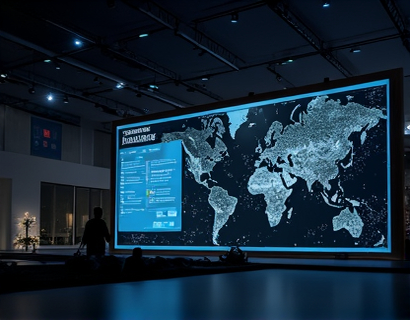Next-Gen QR Code Innovations: Elevating Business and Social Media Engagement for Modern Brands
In the rapidly evolving digital landscape, businesses and social media managers are constantly seeking innovative solutions to enhance engagement and connectivity with their audience. One such technology that has emerged as a game-changer is the next-generation QR Code, often referred to as enhanced or intelligent QR Codes. These advanced QR Codes go beyond the traditional static barcode, offering customizable and intuitive tools that streamline information sharing and significantly boost customer interaction. This article delves into the transformative potential of these next-gen QR Codes, exploring how they are redefining business and social media engagement for modern brands.
The Evolution of QR Codes
QR Codes, or Quick Response Codes, were first developed in the 1990s primarily for tracking parts in vehicle manufacturing. Over the years, they have found widespread use in various sectors, from marketing and advertising to logistics and healthcare. Traditional QR Codes are two-dimensional barcodes that can store text, URLs, and other data. However, their static nature and limited capabilities have been a constraint. The evolution to next-gen QR Codes addresses these limitations, introducing a suite of features that make them more versatile and user-friendly.
Key Features of Next-Gen QR Codes
Next-gen QR Codes incorporate several advanced features that set them apart from their predecessors. These include:
- Dynamic Content: Unlike static QR Codes that link to a fixed URL, dynamic QR Codes can be updated in real-time. This means that the information linked to a QR Code can change without needing to create a new code. For businesses, this flexibility is invaluable, allowing for timely updates to promotions, product information, and more.
- Multi-Language Support: Next-gen QR Codes can store text in multiple languages, making them ideal for global brands and multinational companies. This feature ensures that the content is accessible to a wider audience, enhancing international engagement.
- Rich Media Integration: These QR Codes can link to various media types, including videos, audio files, and interactive web pages. This rich media integration provides a more immersive and engaging experience for users, increasing the likelihood of interaction and sharing.
- Enhanced Security: With built-in security features, next-gen QR Codes can protect sensitive information and prevent unauthorized access. This is particularly important for businesses handling confidential data or conducting secure transactions.
- Customizable Designs: Modern QR Codes can be customized with brand colors, logos, and shapes, allowing brands to maintain consistency across their marketing materials. This personalization helps in building brand recognition and trust.
Benefits for Businesses
The adoption of next-gen QR Codes offers numerous benefits for businesses looking to enhance their digital presence and customer engagement:
Firstly, the dynamic nature of these QR Codes allows for real-time updates, ensuring that the information provided to customers is always current. This is particularly useful for businesses that frequently update their product offerings, promotions, or service details. By maintaining up-to-date information, companies can avoid customer frustration and build trust.
Secondly, the multi-language support makes these QR Codes accessible to a global audience. For businesses operating in multiple countries or targeting international customers, this feature ensures that language barriers do not hinder engagement. It also demonstrates a commitment to inclusivity and customer convenience.
Thirdly, the integration of rich media content through next-gen QR Codes can significantly enhance user experience. Instead of just linking to a text-based webpage, businesses can direct customers to engaging videos, interactive demos, or detailed product tutorials. This not only captures the user's attention but also provides a more comprehensive understanding of the product or service.
Lastly, the enhanced security features provide peace of mind for both businesses and customers. By ensuring that the information shared through QR Codes is secure, companies can protect their brand reputation and maintain customer trust. This is especially crucial in industries dealing with financial transactions, personal data, or sensitive information.
Boosting Social Media Engagement
Social media platforms have become central to modern marketing strategies, and next-gen QR Codes offer a powerful tool to amplify engagement on these platforms:
First, QR Codes can be used to drive traffic to social media profiles or specific posts. By placing a QR Code on physical materials such as flyers, business cards, or event signage, businesses can seamlessly connect offline interactions to online engagement. This bridge between the physical and digital worlds enhances the overall customer journey.
Second, the ability to link to rich media content through QR Codes can create more engaging social media experiences. For instance, a brand can share a QR Code that leads to an exclusive behind-the-scenes video or an interactive quiz. Such content not only increases engagement but also encourages sharing, expanding the brand's reach organically.
Third, the customizable design of next-gen QR Codes aligns perfectly with social media aesthetics. Brands can design QR Codes that match their visual identity, making them visually appealing and consistent with their social media presence. This cohesive approach reinforces brand recognition and professionalism.
Lastly, the use of QR Codes in social media contests and giveaways can boost participation and excitement. For example, a brand can create a QR Code that, when scanned, enters the user into a draw for a prize. This interactive element not only increases engagement but also collects valuable customer data through sign-up forms or surveys.
Case Studies and Real-World Applications
To better understand the practical applications and impact of next-gen QR Codes, let's explore a few real-world examples:
One notable example is in the retail sector, where a major clothing brand implemented dynamic QR Codes on their product tags. These QR Codes linked to detailed product pages, including videos of the garments being modeled, customer reviews, and styling tips. This approach not only enhanced the shopping experience but also increased conversion rates by providing comprehensive information at the point of purchase.
In the hospitality industry, a luxury hotel chain used QR Codes in their guest rooms to provide access to a personalized welcome video, local attraction guides, and digital concierge services. The dynamic nature of the QR Codes allowed the hotel to update the content seasonally or based on special events, keeping the guest experience fresh and relevant.
Another example comes from the event industry, where a music festival used QR Codes for ticketing and access control. The QR Codes not only streamlined the entry process but also linked to exclusive content such as artist interviews, behind-the-scenes footage, and interactive maps of the festival grounds. This enriched the attendee experience and fostered a stronger connection with the event brand.
Implementation and Best Practices
For businesses looking to integrate next-gen QR Codes into their strategies, here are some best practices to consider:
First, define clear objectives for using QR Codes. Whether it's to drive website traffic, increase social media engagement, or collect customer data, having a clear goal will guide the implementation process.
Second, choose a reliable QR Code generator that offers the desired features, such as dynamic updates and multi-language support. Ensure that the service provider has a good track record and positive customer reviews.
Third, test the QR Codes thoroughly before deployment. Ensure that they are scannable across different devices and in various lighting conditions. This step helps prevent user frustration and maintains a positive brand image.
Fourth, place QR Codes in strategic locations where they will be easily noticed and accessed by the target audience. Consider the context and environment to maximize visibility and interaction.
Lastly, monitor and analyze the performance of QR Codes using analytics tools. Track metrics such as scan rates, user engagement, and conversion rates to gauge the effectiveness of the QR Code campaign and make data-driven adjustments.
Conclusion
Next-gen QR Codes represent a significant advancement in the realm of digital engagement tools. Their customizable, intuitive, and feature-rich nature makes them an invaluable asset for modern brands aiming to enhance their digital presence and connect more effectively with their audience. By leveraging these innovative QR Codes, businesses can create more engaging, secure, and personalized experiences that drive interaction and loyalty. As the digital landscape continues to evolve, embracing next-gen QR Code technology will undoubtedly give brands a competitive edge in the quest for enhanced engagement and success.










































